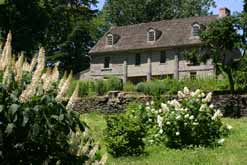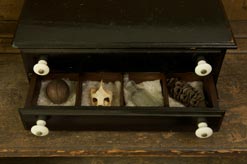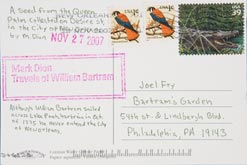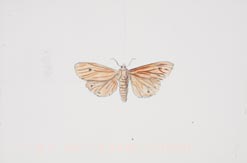





Travels of William Bartram – Reconsidered
In 2007 I approached The John Bartram Association, who manages Bartram’s Garden, America’s oldest living botanic garden to invite Mark Dion to create a project for the historic site. Dion envisioned the project as “the quintessential exploratory road trip: part Lewis and Clark, part Jack Kerouac, part Pee Wee’s Big Adventure, and part Borat”.
With funding from the Philadelphia Exhibitions Initiative and Pew Marketing Initiative Program, both projects of the Philadelphia Center for Arts and Heritage, Mark Dion’s Travels of William Bartram – Reconsidered examined the history and culture of America’s first great naturalists, botanists, and plant explorers, John Bartram (1699-1777) and his son, William Bartram (1739-1823). He loosely traced the expeditions of these 18th century American icons using their travel journals, drawings, and maps to create a unique project that was installed in the historic home of John Bartram. Bartram’s Garden, a 45-acre site situated on the west bank of the Schuylkill River in Philadelphia is one of the city’s hidden treasures. As an artist whose work blurs the boundaries between contemporary art, history, and science, Dion’s deep respect and knowledge about the Bartram legacy in natural science and art, combined with his quirky perspective, made this project thoughtful and amusing.
Dion retraced the exploratory journeys and expeditions of William Bartram, in particular, to northern Florida. He was most interested in William because he was an artist and had a lot of the characteristics of 21st century artists: had trouble getting and keeping a keeping a job, never married, and lived at home when he wasn’t traveling with the Indians, etc. Most of the landscape that Bartram explored has been radically altered by the construction of shopping malls and golf courses. Dion, nevertheless, collected natural specimens and man-made artifacts, and, in keeping with his longstanding interest in mail art, sent them back to Bartram’s Garden. These artifacts and specimens were installed in souvenir cabinets that Dion designed and had built by Pappajohn Woodworkers for the exhibit. One of the cabinets was a postcard cabinet that housed 36 hand-painted postcards depicting various things Dion saw: all sorts of plants and animals, a golf cart, Mickey Mouse, and 19th c. pottery shards. An inveterate flea marketer, archeologist, and naturalist, Dion sent back, among other things, herbarium specimens, fish preserved in alcohol, water samples, kitsch material culture from Florida (e.g. alligator salt and pepper shakers), and collections of toys, knives, shells and bottle caps, all artfully arranged in the manner of natural history museum displays. He collected plant specimens that were dried and mounted on tea-stained acid free paper and placed in a cabinet based on the designs of Linnaeus.
The journey was documented by drawings, photographs, video and audio, and Dion’s personal journal. Much of this was recorded on markdionsbartramstravels.com, a running, interactive account of the journey. Dion is well known for his endless curiosity about the world, his persistent questioning of assumptions, and his gift for making connections where most people see none. His inimitable way of categorizing collections will make this project unique for Bartram’s Garden and enable people to make those connections.
A catalogue designed by Jeffrey Jenkins, with essays by curator Julie Courtney, critic Gregory Volk, and curator of Bartram’s Garden, Joel Fry is available through Temple University Press.
